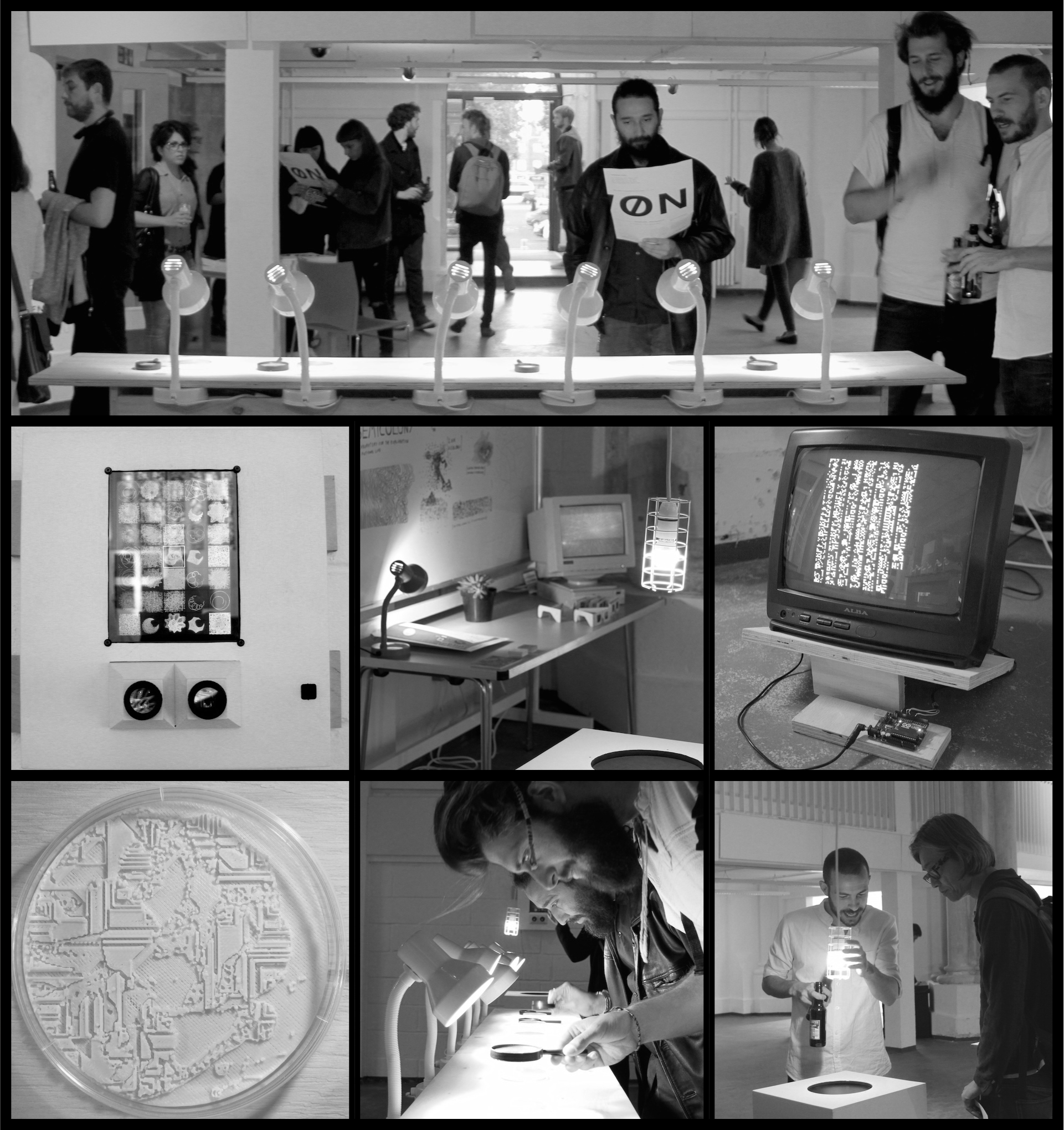MA Computational Arts Thesis Project
Goldsmiths, University of London
2015
Semicolony is a series of software experiments in artificial life, conducted over the course of a year. Each experiment aims to recreate specific phenomena associated with living systems as abstract processes within a virtual environment. The project adopts a unique aesthetic that blurs the line between biomorphic and digital, invoking a sense of exploration into the vast space between living and non-living realms. Ultimately, it raises questions about what constitutes a living entity.
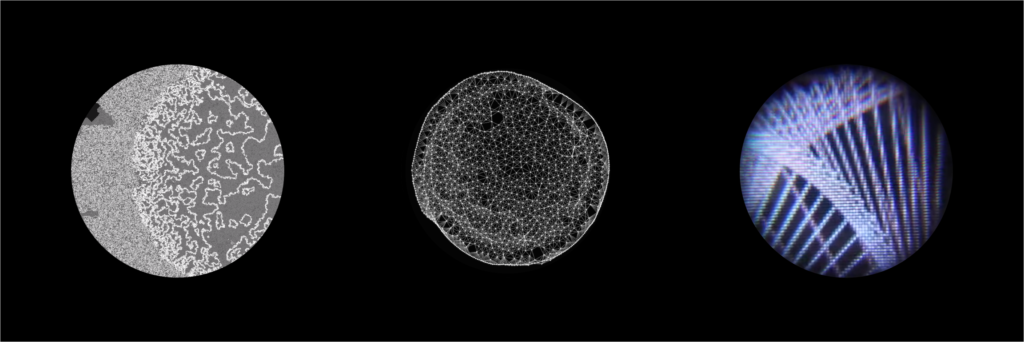
The installation is an interactive study of nonlinear systems, evolution, emergence, and morphogenesis. It takes the form of a fictional laboratory, offering instruments for observing, exploring, and interacting with fictional life forms. Drawing design cues from iconic 80s consumer electronics, the lab invites visitors into a familiar yet intriguingly estranged experience. The organisms featured in Semicolony not only provide a glimpse into their unlikely existence but also rely on the viewer’s attention for their survival.
Evolutionary Algorithms
Revolving is an interactive genetic experiment that allows observers to guide the evolution of dynamic graphical elements towards aesthetically pleasing configurations over time. This open-ended process relies heavily on intuition and aesthetic preference, examining how simple modes of interaction can drive complex processes over extended periods.
The graphical elements can be any structure with numerically defined properties. Initial experiments included color sequences, poly-lines, spirographs (epitrochoids), superformulae, 3D rigid body simulations, and later, cellular automata. The process begins with a population of randomly generated configurations, allowing selection of any number of specimens. Various interfaces were considered for this experiment, including eye tracking, mouse selection, and single-click timed iterations. A new generation of individuals is then created by combining the numerical properties of the selected configurations. The new generation is displayed, and the process repeats.
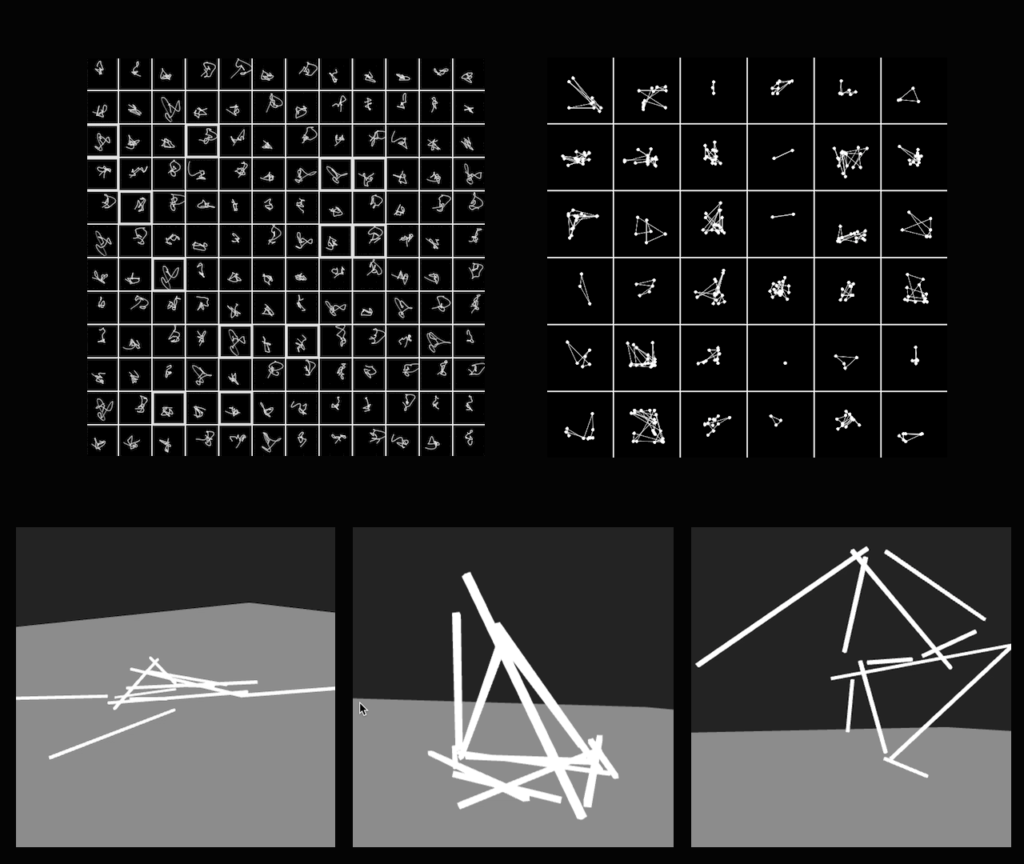
Interactive evolutionary algorithms are inherently slower than automatic fitness selection, making them unsuitable for problems with unknown but well-defined solutions. However, in a computational arts context, an interactive approach can explore configuration spaces that are neither known nor well-defined. Mutation and cross-breeding are more dramatic compared to biological evolution or automated computational methods. This is necessary for noticeable changes between generations. The number of individuals per generation is also limited to facilitate effective observation and selection, as this becomes challenging with more than a few dozen specimens.
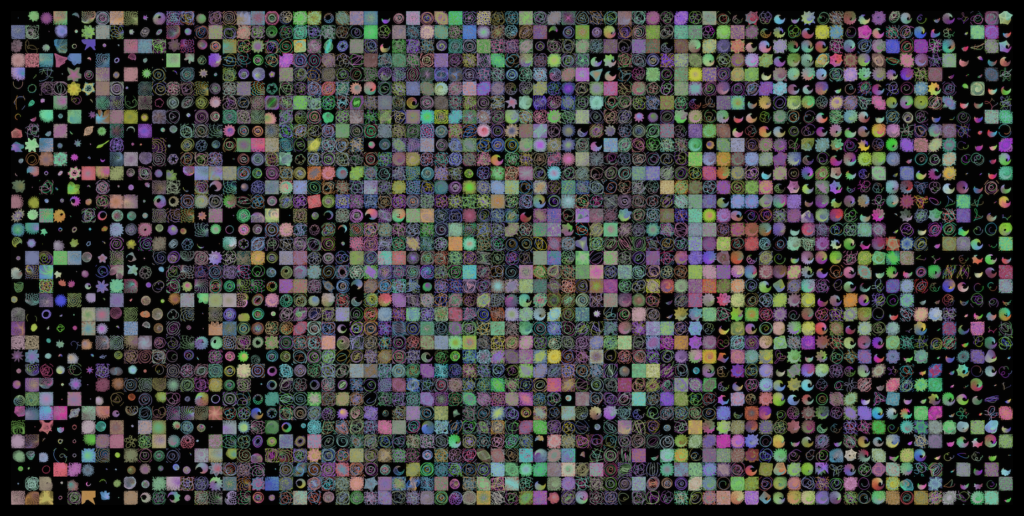
Despite these limitations, the experiment demonstrates how a simple and intuitive selection process can drive the evolution of dynamic visual imagery through a high-dimensional space of possible configurations. For the final degree show, this experiment was implemented as a standalone custom-embedded computer featuring a stereoscopic display and a sensing mechanism to measure audience engagement. Over a four-day exhibition, the genealogy shown above spanned 70 generations. Visual examination reveals the diversification caused by audience surges during the opening and closing nights.
Swarm Dynamics
Individual Life Form is a study of morphogenesis through group dynamics. The experiment begins with a single point (a vertex) in virtual 3D space, possessing a finite amount of energy. This energy allows the vertex to move autonomously or spawn a new vertex, with offspring carrying slightly mutated attributes such as color and various heuristics. Once all energy is depleted, the vertex essentially “dies,” revealing its skeletal structure. To avoid rapid exponential growth, the lifespan, energy, range of motion, and rate of reproduction are carefully balanced, resulting in a visual resemblance to plant morphology.
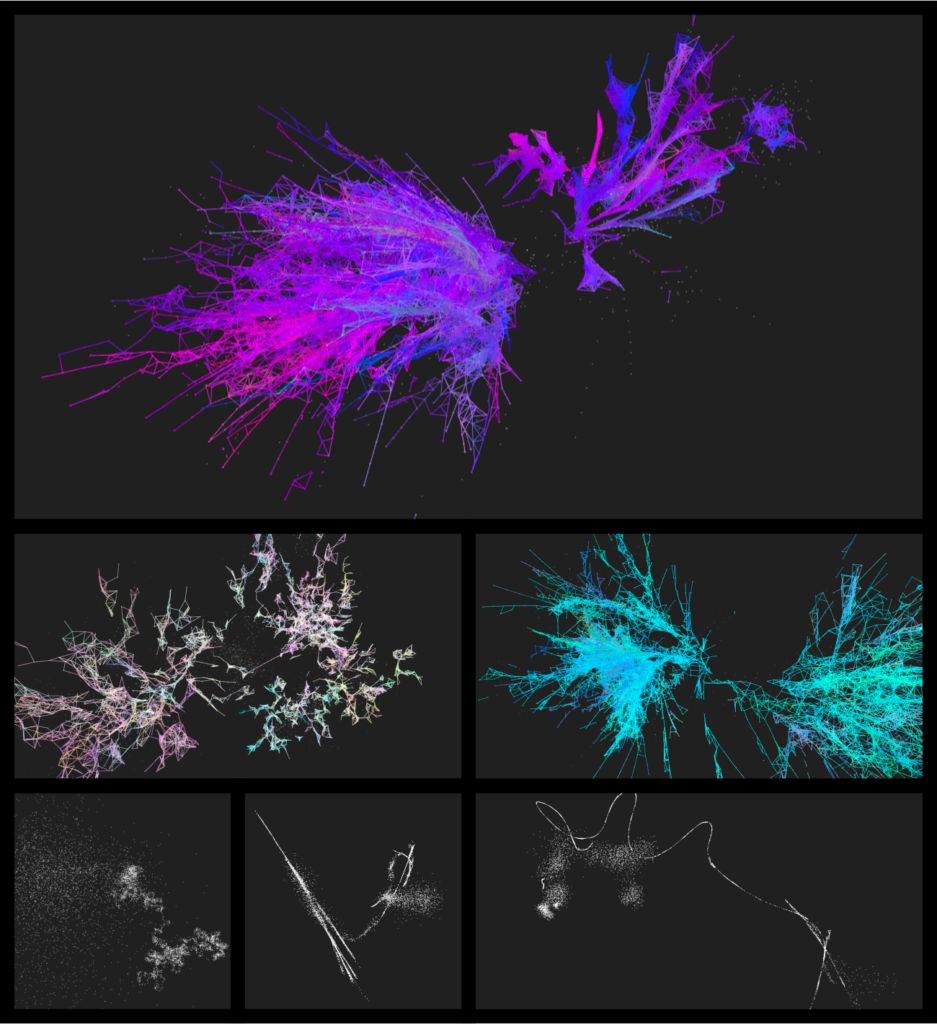
Designed with both technical and conceptual goals, the experiment is written in C++/openFrameworks, combining and altering several computational models into a single codebase. Vertex motion is based on the Boids model [Reynolds 1987], combined with nearest neighbor searching for optimal framerate. Conceptually, it serves as a proof-of-concept for a hybrid approach, demonstrating how swarming, mutation, and cell division behaviors can be combined to produce biomorphic behavior without modeling any specific physical phenomenon.
Type-B is an audio-visual live performance tool featuring a population of points that can move, interact, spawn, die, and react to live audio. The software was used to produce sound-reactive visuals for The Infinite Bridge, a multidisciplinary live performance project that premiered at the Royal College of Music in May 2015.
Harnessing complex dynamical systems for live performance holds great potential for diversifying visual outcomes. However, this also poses a challenge: due to the inherently unpredictable nature of these systems, they are notoriously hard to control. Much of the work in creating this type of software involves tweaking its parameters to maximize autonomy while retaining sufficient control. Constraining the system’s parameters ensures consistent and reliable behavior during performance but can make it monotonous and predictable. Conversely, allowing the system too much freedom can result in a wider expressive range but at the cost of unpredictability and unreliability. It is not unlikely for a sufficiently sophisticated swarm implementation to suddenly “leave the stage” in the middle of a show.
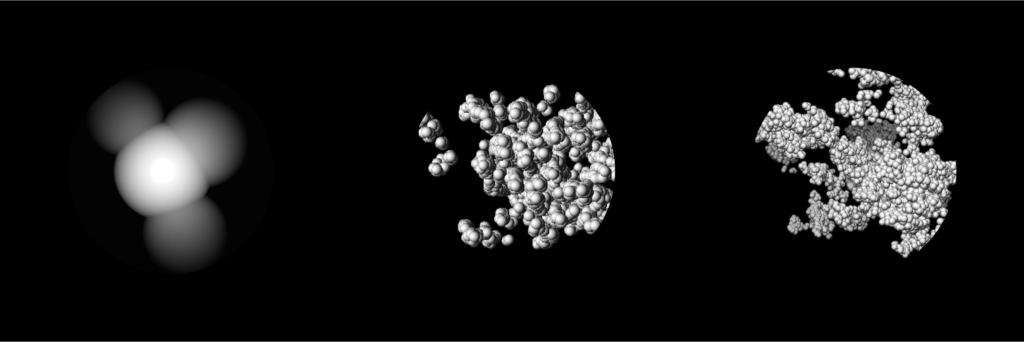

Type-B addresses this narrow window by maintaining a constant tension between real-time, centralized commands from a human operator and the distributed forces driving the swarm’s intricate behavior. This tension enables different forces and constraints to be exerted and relaxed in real-time. This interactive approach seeks to strike a balance between usability and expressive range, resulting in a manageable tool capable of expressing an unusually wide range of spatial network topologies.
Additionally, each member of the swarm “listens” to a specific frequency range in an incoming audio stream. When certain frequencies are more present, the corresponding members absorb more “energy”, gaining increased freedom of motion and the ability to spawn new members, which subscribe to a similar frequency range. Conversely, when a frequency is absent, its subscribing members quickly die out. The sound input thus acts as a “force of nature,” regulating population dynamics and allowing the swarm to be sound reactive by virtue of natural selection.
Cellular Automata
Type-C is cellular automata experiment which features a hardware accelerated implementation of the Abelian Sandpile algorithm — a simulation in which virtual “grains of sand” are continuously dropped upon a lattice to form “piles”. Once a stack of four grains is formed in any cell, it would “collapse” and disperse among the cell’s four adjacent neighbours. In turn, this may result in further collapses and ultimately form large scale avalanches and intricate structures. The experiment set out to implement the Sandpile algorithm as a continuous state CA, whereby instead of consisting of discrete entities (sand grains), continuous quantities would be added to the system in real time using the mouse cursor.
Instead of using discrete values to describe the state of each cell (originally between 0 and 4), the model was converted to a continuous 32-bit float state. This change transformed the sand metaphor into something less tangible. The new values were clamped to normalized (0.0 – 1.0) numbers; however, cells need not necessarily reach 1.0 to collapse. Continuous state cellular automata are less commonly known than discrete state models, but they can express a much wider range of phenomena.

The original sandpile algorithm dictates that when a cell collapses, it evenly distributes its contents so that the total number of grains persists. In Type-C, the contents of a collapsing cell may exceed its maximal capacity, allowing each of its four neighbors to absorb a quantity larger (or smaller) than 25%. The amount gained by each neighbor is defined uniformly across all cells as a variable ranging between 0.0 and 1.0.
These differences amount to relinquishing the idea of conservation of matter, which is baked into in the original model. They result in the introduction of surprising and novel emergent behaviour. Interestingly, these newly discovered formations bear almost no resemblance to the original sandpile algorithm. For the final exhibition, several variations were 3D printed to form a collection of petri dishes. A custom-built light-sensitive embedded computer was also constructed, allowing playful and intuitive interaction using a light source.
